Case Study: Cultural, Societal, and Ethical Implications in Healthcare
VerifiedAdded on 2021/04/21
|13
|3091
|33
Report
AI Summary
This report presents a case study examining discrimination within a community healthcare center. The core issue revolves around the distribution of breast cancer awareness materials solely in English, thereby excluding non-English speaking residents. The report delves into the manager's biased behavior and its ethical implications, framed within sociological concepts like social categorization and social identity theory. It analyzes the case as an instance of racial discrimination in service provision, specifically highlighting direct and perceptive discrimination. The analysis explores the societal impact of such practices, emphasizing the importance of equitable healthcare access. Finally, the report suggests potential solutions, including eliminating personal biases, translating materials, and utilizing audio-visual aids to bridge the language barrier and promote inclusivity within the community healthcare center, ensuring the effective dissemination of vital health information and services.
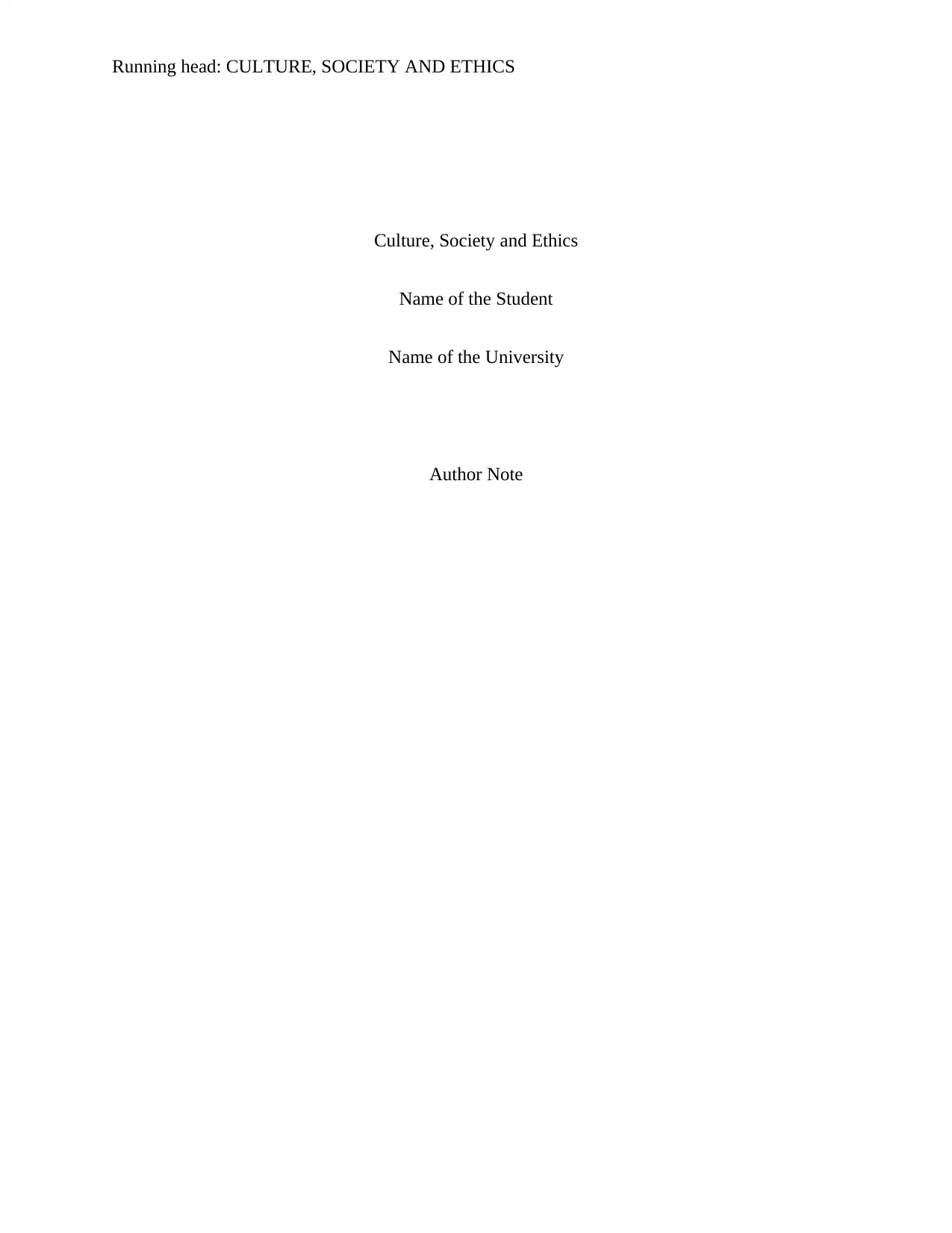
Running head: CULTURE, SOCIETY AND ETHICS
Culture, Society and Ethics
Name of the Student
Name of the University
Author Note
Culture, Society and Ethics
Name of the Student
Name of the University
Author Note
Paraphrase This Document
Need a fresh take? Get an instant paraphrase of this document with our AI Paraphraser
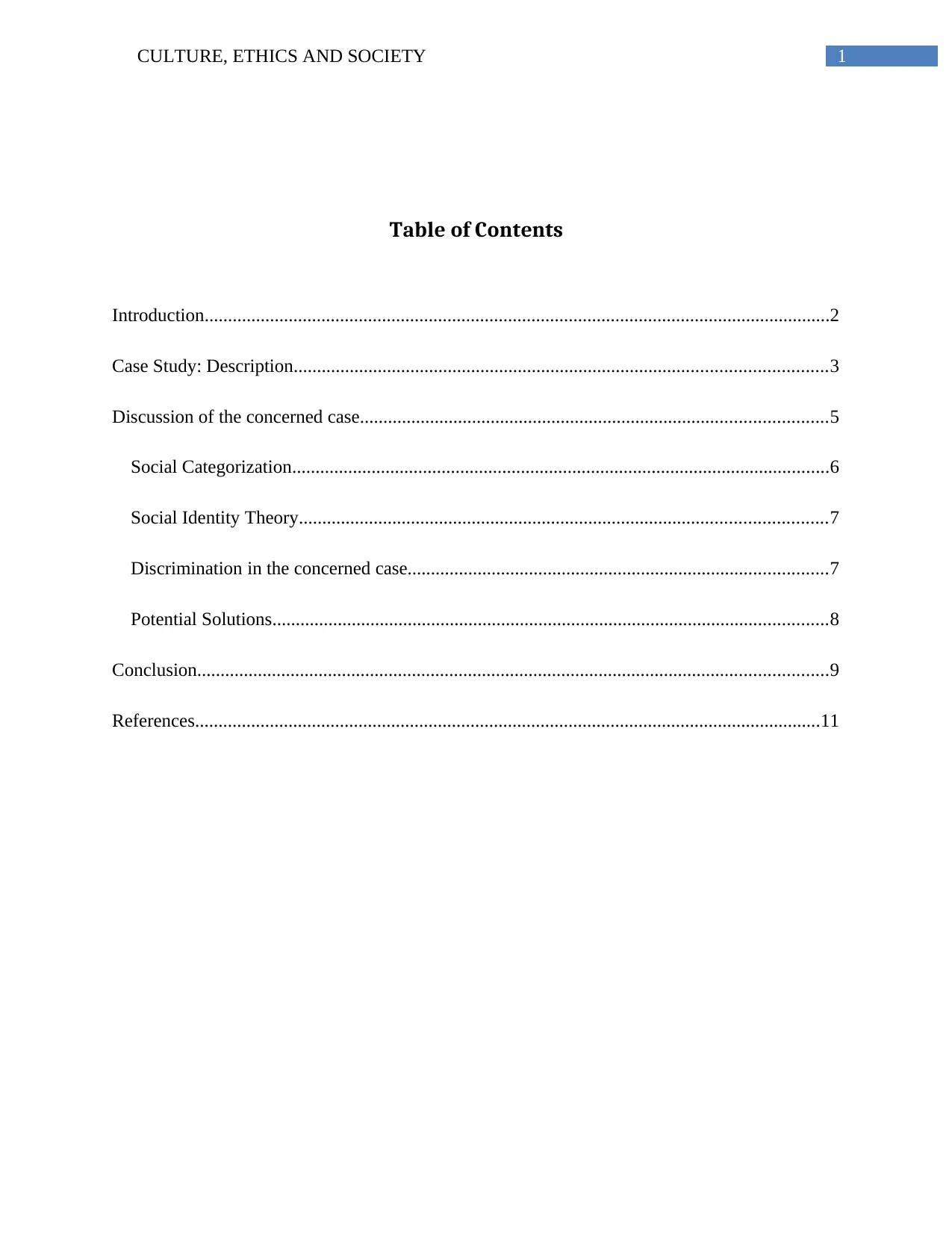
1CULTURE, ETHICS AND SOCIETY
Table of Contents
Introduction......................................................................................................................................2
Case Study: Description..................................................................................................................3
Discussion of the concerned case....................................................................................................5
Social Categorization...................................................................................................................6
Social Identity Theory.................................................................................................................7
Discrimination in the concerned case..........................................................................................7
Potential Solutions.......................................................................................................................8
Conclusion.......................................................................................................................................9
References......................................................................................................................................11
Table of Contents
Introduction......................................................................................................................................2
Case Study: Description..................................................................................................................3
Discussion of the concerned case....................................................................................................5
Social Categorization...................................................................................................................6
Social Identity Theory.................................................................................................................7
Discrimination in the concerned case..........................................................................................7
Potential Solutions.......................................................................................................................8
Conclusion.......................................................................................................................................9
References......................................................................................................................................11
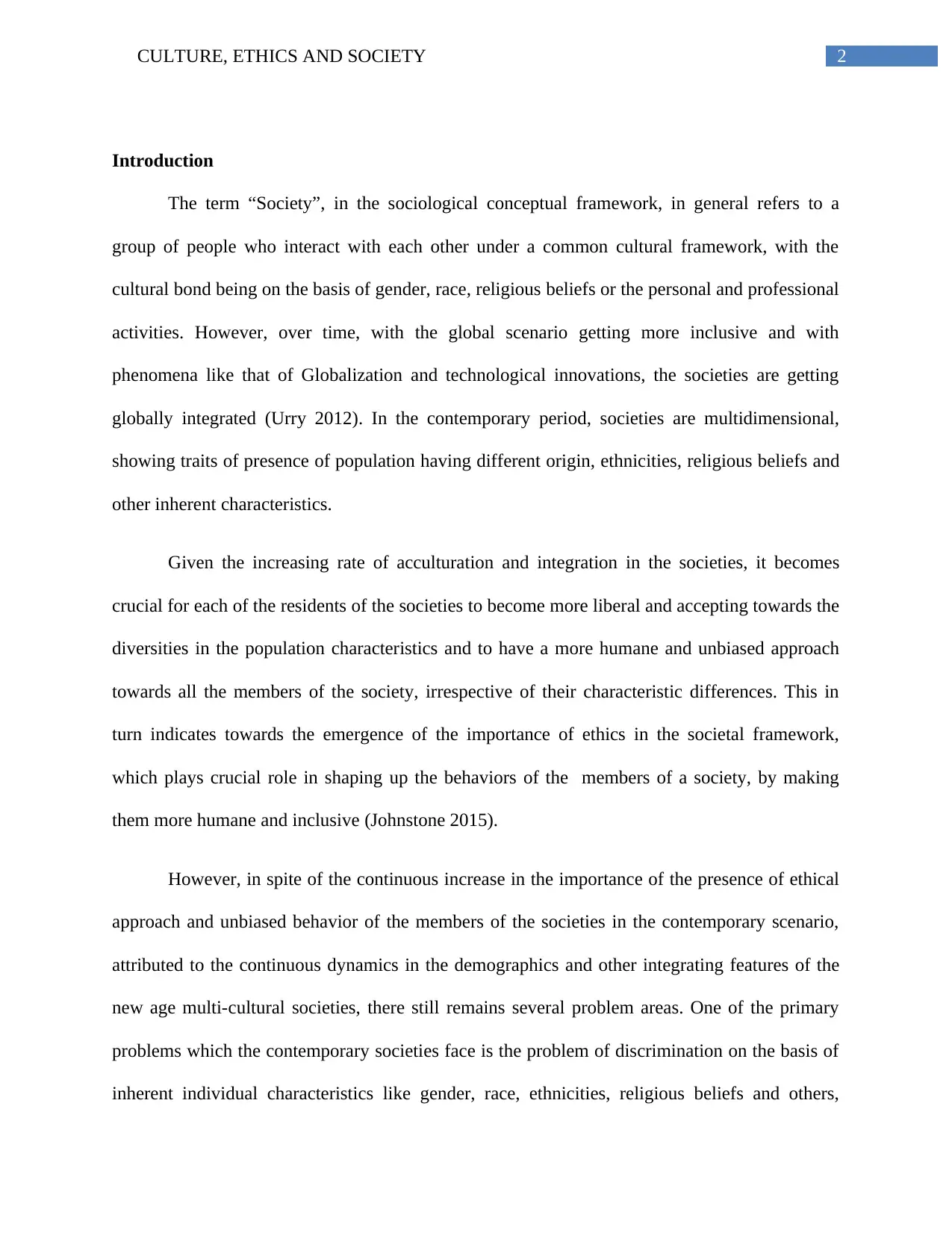
2CULTURE, ETHICS AND SOCIETY
Introduction
The term “Society”, in the sociological conceptual framework, in general refers to a
group of people who interact with each other under a common cultural framework, with the
cultural bond being on the basis of gender, race, religious beliefs or the personal and professional
activities. However, over time, with the global scenario getting more inclusive and with
phenomena like that of Globalization and technological innovations, the societies are getting
globally integrated (Urry 2012). In the contemporary period, societies are multidimensional,
showing traits of presence of population having different origin, ethnicities, religious beliefs and
other inherent characteristics.
Given the increasing rate of acculturation and integration in the societies, it becomes
crucial for each of the residents of the societies to become more liberal and accepting towards the
diversities in the population characteristics and to have a more humane and unbiased approach
towards all the members of the society, irrespective of their characteristic differences. This in
turn indicates towards the emergence of the importance of ethics in the societal framework,
which plays crucial role in shaping up the behaviors of the members of a society, by making
them more humane and inclusive (Johnstone 2015).
However, in spite of the continuous increase in the importance of the presence of ethical
approach and unbiased behavior of the members of the societies in the contemporary scenario,
attributed to the continuous dynamics in the demographics and other integrating features of the
new age multi-cultural societies, there still remains several problem areas. One of the primary
problems which the contemporary societies face is the problem of discrimination on the basis of
inherent individual characteristics like gender, race, ethnicities, religious beliefs and others,
Introduction
The term “Society”, in the sociological conceptual framework, in general refers to a
group of people who interact with each other under a common cultural framework, with the
cultural bond being on the basis of gender, race, religious beliefs or the personal and professional
activities. However, over time, with the global scenario getting more inclusive and with
phenomena like that of Globalization and technological innovations, the societies are getting
globally integrated (Urry 2012). In the contemporary period, societies are multidimensional,
showing traits of presence of population having different origin, ethnicities, religious beliefs and
other inherent characteristics.
Given the increasing rate of acculturation and integration in the societies, it becomes
crucial for each of the residents of the societies to become more liberal and accepting towards the
diversities in the population characteristics and to have a more humane and unbiased approach
towards all the members of the society, irrespective of their characteristic differences. This in
turn indicates towards the emergence of the importance of ethics in the societal framework,
which plays crucial role in shaping up the behaviors of the members of a society, by making
them more humane and inclusive (Johnstone 2015).
However, in spite of the continuous increase in the importance of the presence of ethical
approach and unbiased behavior of the members of the societies in the contemporary scenario,
attributed to the continuous dynamics in the demographics and other integrating features of the
new age multi-cultural societies, there still remains several problem areas. One of the primary
problems which the contemporary societies face is the problem of discrimination on the basis of
inherent individual characteristics like gender, race, ethnicities, religious beliefs and others,
⊘ This is a preview!⊘
Do you want full access?
Subscribe today to unlock all pages.

Trusted by 1+ million students worldwide
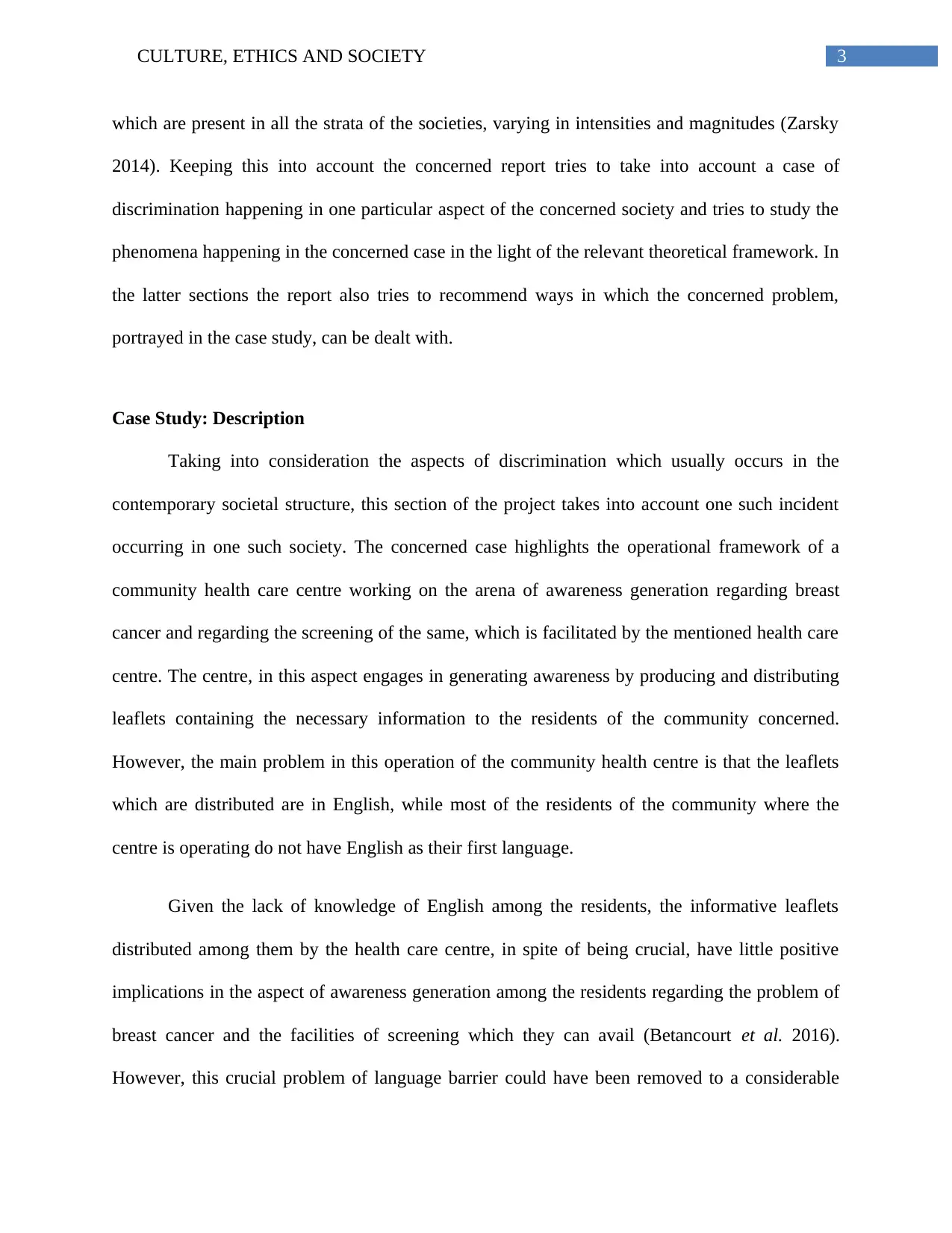
3CULTURE, ETHICS AND SOCIETY
which are present in all the strata of the societies, varying in intensities and magnitudes (Zarsky
2014). Keeping this into account the concerned report tries to take into account a case of
discrimination happening in one particular aspect of the concerned society and tries to study the
phenomena happening in the concerned case in the light of the relevant theoretical framework. In
the latter sections the report also tries to recommend ways in which the concerned problem,
portrayed in the case study, can be dealt with.
Case Study: Description
Taking into consideration the aspects of discrimination which usually occurs in the
contemporary societal structure, this section of the project takes into account one such incident
occurring in one such society. The concerned case highlights the operational framework of a
community health care centre working on the arena of awareness generation regarding breast
cancer and regarding the screening of the same, which is facilitated by the mentioned health care
centre. The centre, in this aspect engages in generating awareness by producing and distributing
leaflets containing the necessary information to the residents of the community concerned.
However, the main problem in this operation of the community health centre is that the leaflets
which are distributed are in English, while most of the residents of the community where the
centre is operating do not have English as their first language.
Given the lack of knowledge of English among the residents, the informative leaflets
distributed among them by the health care centre, in spite of being crucial, have little positive
implications in the aspect of awareness generation among the residents regarding the problem of
breast cancer and the facilities of screening which they can avail (Betancourt et al. 2016).
However, this crucial problem of language barrier could have been removed to a considerable
which are present in all the strata of the societies, varying in intensities and magnitudes (Zarsky
2014). Keeping this into account the concerned report tries to take into account a case of
discrimination happening in one particular aspect of the concerned society and tries to study the
phenomena happening in the concerned case in the light of the relevant theoretical framework. In
the latter sections the report also tries to recommend ways in which the concerned problem,
portrayed in the case study, can be dealt with.
Case Study: Description
Taking into consideration the aspects of discrimination which usually occurs in the
contemporary societal structure, this section of the project takes into account one such incident
occurring in one such society. The concerned case highlights the operational framework of a
community health care centre working on the arena of awareness generation regarding breast
cancer and regarding the screening of the same, which is facilitated by the mentioned health care
centre. The centre, in this aspect engages in generating awareness by producing and distributing
leaflets containing the necessary information to the residents of the community concerned.
However, the main problem in this operation of the community health centre is that the leaflets
which are distributed are in English, while most of the residents of the community where the
centre is operating do not have English as their first language.
Given the lack of knowledge of English among the residents, the informative leaflets
distributed among them by the health care centre, in spite of being crucial, have little positive
implications in the aspect of awareness generation among the residents regarding the problem of
breast cancer and the facilities of screening which they can avail (Betancourt et al. 2016).
However, this crucial problem of language barrier could have been removed to a considerable
Paraphrase This Document
Need a fresh take? Get an instant paraphrase of this document with our AI Paraphraser
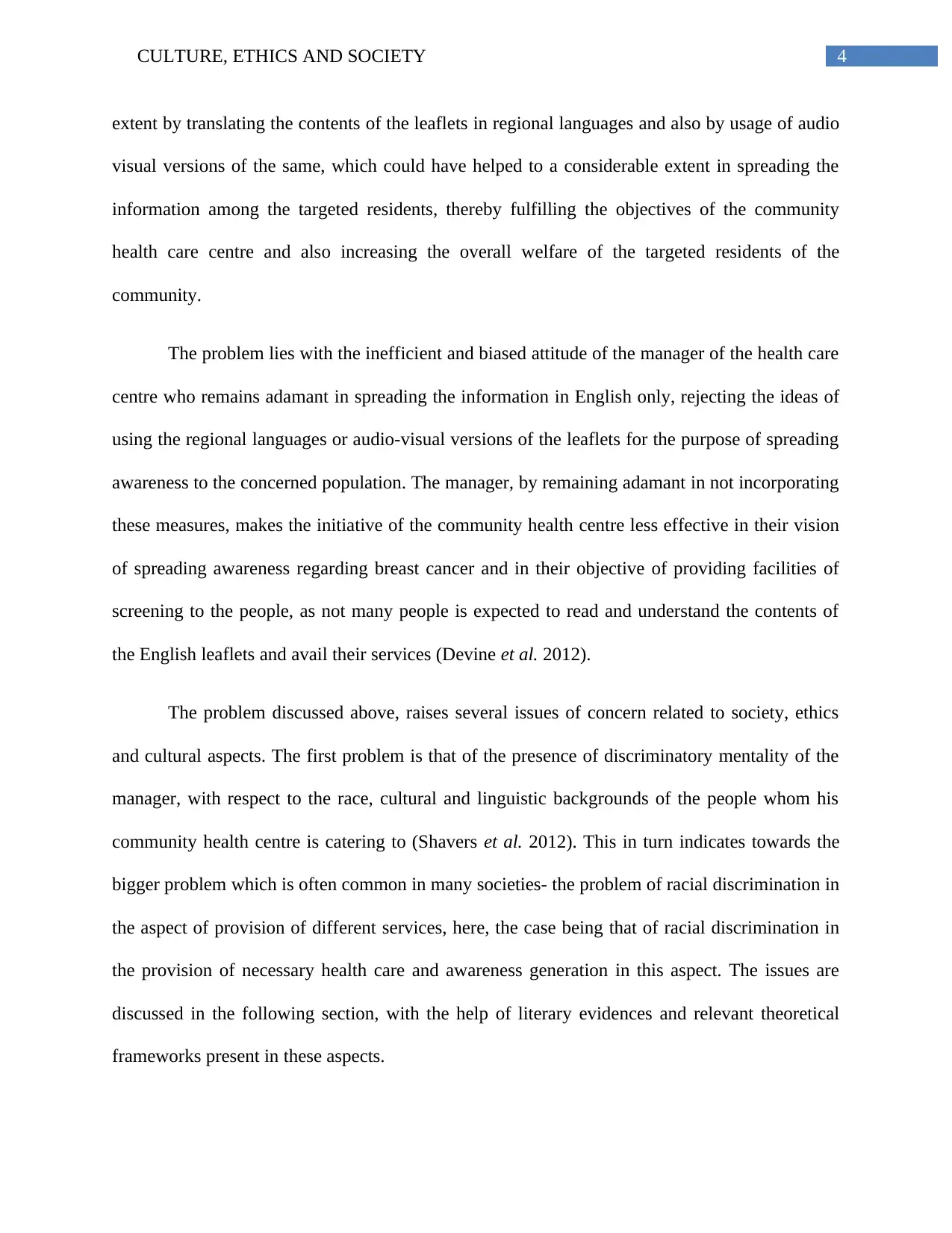
4CULTURE, ETHICS AND SOCIETY
extent by translating the contents of the leaflets in regional languages and also by usage of audio
visual versions of the same, which could have helped to a considerable extent in spreading the
information among the targeted residents, thereby fulfilling the objectives of the community
health care centre and also increasing the overall welfare of the targeted residents of the
community.
The problem lies with the inefficient and biased attitude of the manager of the health care
centre who remains adamant in spreading the information in English only, rejecting the ideas of
using the regional languages or audio-visual versions of the leaflets for the purpose of spreading
awareness to the concerned population. The manager, by remaining adamant in not incorporating
these measures, makes the initiative of the community health centre less effective in their vision
of spreading awareness regarding breast cancer and in their objective of providing facilities of
screening to the people, as not many people is expected to read and understand the contents of
the English leaflets and avail their services (Devine et al. 2012).
The problem discussed above, raises several issues of concern related to society, ethics
and cultural aspects. The first problem is that of the presence of discriminatory mentality of the
manager, with respect to the race, cultural and linguistic backgrounds of the people whom his
community health centre is catering to (Shavers et al. 2012). This in turn indicates towards the
bigger problem which is often common in many societies- the problem of racial discrimination in
the aspect of provision of different services, here, the case being that of racial discrimination in
the provision of necessary health care and awareness generation in this aspect. The issues are
discussed in the following section, with the help of literary evidences and relevant theoretical
frameworks present in these aspects.
extent by translating the contents of the leaflets in regional languages and also by usage of audio
visual versions of the same, which could have helped to a considerable extent in spreading the
information among the targeted residents, thereby fulfilling the objectives of the community
health care centre and also increasing the overall welfare of the targeted residents of the
community.
The problem lies with the inefficient and biased attitude of the manager of the health care
centre who remains adamant in spreading the information in English only, rejecting the ideas of
using the regional languages or audio-visual versions of the leaflets for the purpose of spreading
awareness to the concerned population. The manager, by remaining adamant in not incorporating
these measures, makes the initiative of the community health centre less effective in their vision
of spreading awareness regarding breast cancer and in their objective of providing facilities of
screening to the people, as not many people is expected to read and understand the contents of
the English leaflets and avail their services (Devine et al. 2012).
The problem discussed above, raises several issues of concern related to society, ethics
and cultural aspects. The first problem is that of the presence of discriminatory mentality of the
manager, with respect to the race, cultural and linguistic backgrounds of the people whom his
community health centre is catering to (Shavers et al. 2012). This in turn indicates towards the
bigger problem which is often common in many societies- the problem of racial discrimination in
the aspect of provision of different services, here, the case being that of racial discrimination in
the provision of necessary health care and awareness generation in this aspect. The issues are
discussed in the following section, with the help of literary evidences and relevant theoretical
frameworks present in these aspects.
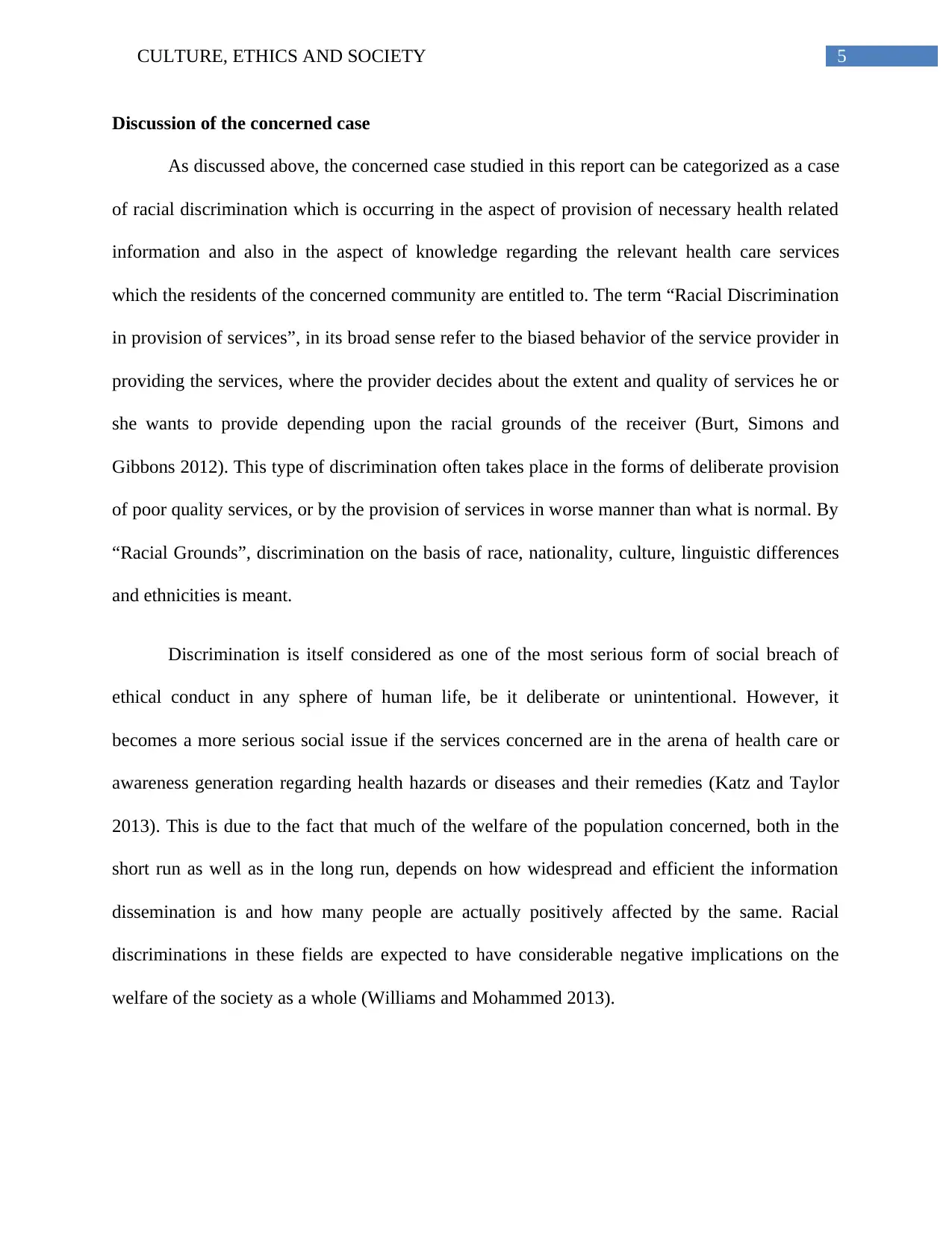
5CULTURE, ETHICS AND SOCIETY
Discussion of the concerned case
As discussed above, the concerned case studied in this report can be categorized as a case
of racial discrimination which is occurring in the aspect of provision of necessary health related
information and also in the aspect of knowledge regarding the relevant health care services
which the residents of the concerned community are entitled to. The term “Racial Discrimination
in provision of services”, in its broad sense refer to the biased behavior of the service provider in
providing the services, where the provider decides about the extent and quality of services he or
she wants to provide depending upon the racial grounds of the receiver (Burt, Simons and
Gibbons 2012). This type of discrimination often takes place in the forms of deliberate provision
of poor quality services, or by the provision of services in worse manner than what is normal. By
“Racial Grounds”, discrimination on the basis of race, nationality, culture, linguistic differences
and ethnicities is meant.
Discrimination is itself considered as one of the most serious form of social breach of
ethical conduct in any sphere of human life, be it deliberate or unintentional. However, it
becomes a more serious social issue if the services concerned are in the arena of health care or
awareness generation regarding health hazards or diseases and their remedies (Katz and Taylor
2013). This is due to the fact that much of the welfare of the population concerned, both in the
short run as well as in the long run, depends on how widespread and efficient the information
dissemination is and how many people are actually positively affected by the same. Racial
discriminations in these fields are expected to have considerable negative implications on the
welfare of the society as a whole (Williams and Mohammed 2013).
Discussion of the concerned case
As discussed above, the concerned case studied in this report can be categorized as a case
of racial discrimination which is occurring in the aspect of provision of necessary health related
information and also in the aspect of knowledge regarding the relevant health care services
which the residents of the concerned community are entitled to. The term “Racial Discrimination
in provision of services”, in its broad sense refer to the biased behavior of the service provider in
providing the services, where the provider decides about the extent and quality of services he or
she wants to provide depending upon the racial grounds of the receiver (Burt, Simons and
Gibbons 2012). This type of discrimination often takes place in the forms of deliberate provision
of poor quality services, or by the provision of services in worse manner than what is normal. By
“Racial Grounds”, discrimination on the basis of race, nationality, culture, linguistic differences
and ethnicities is meant.
Discrimination is itself considered as one of the most serious form of social breach of
ethical conduct in any sphere of human life, be it deliberate or unintentional. However, it
becomes a more serious social issue if the services concerned are in the arena of health care or
awareness generation regarding health hazards or diseases and their remedies (Katz and Taylor
2013). This is due to the fact that much of the welfare of the population concerned, both in the
short run as well as in the long run, depends on how widespread and efficient the information
dissemination is and how many people are actually positively affected by the same. Racial
discriminations in these fields are expected to have considerable negative implications on the
welfare of the society as a whole (Williams and Mohammed 2013).
⊘ This is a preview!⊘
Do you want full access?
Subscribe today to unlock all pages.

Trusted by 1+ million students worldwide
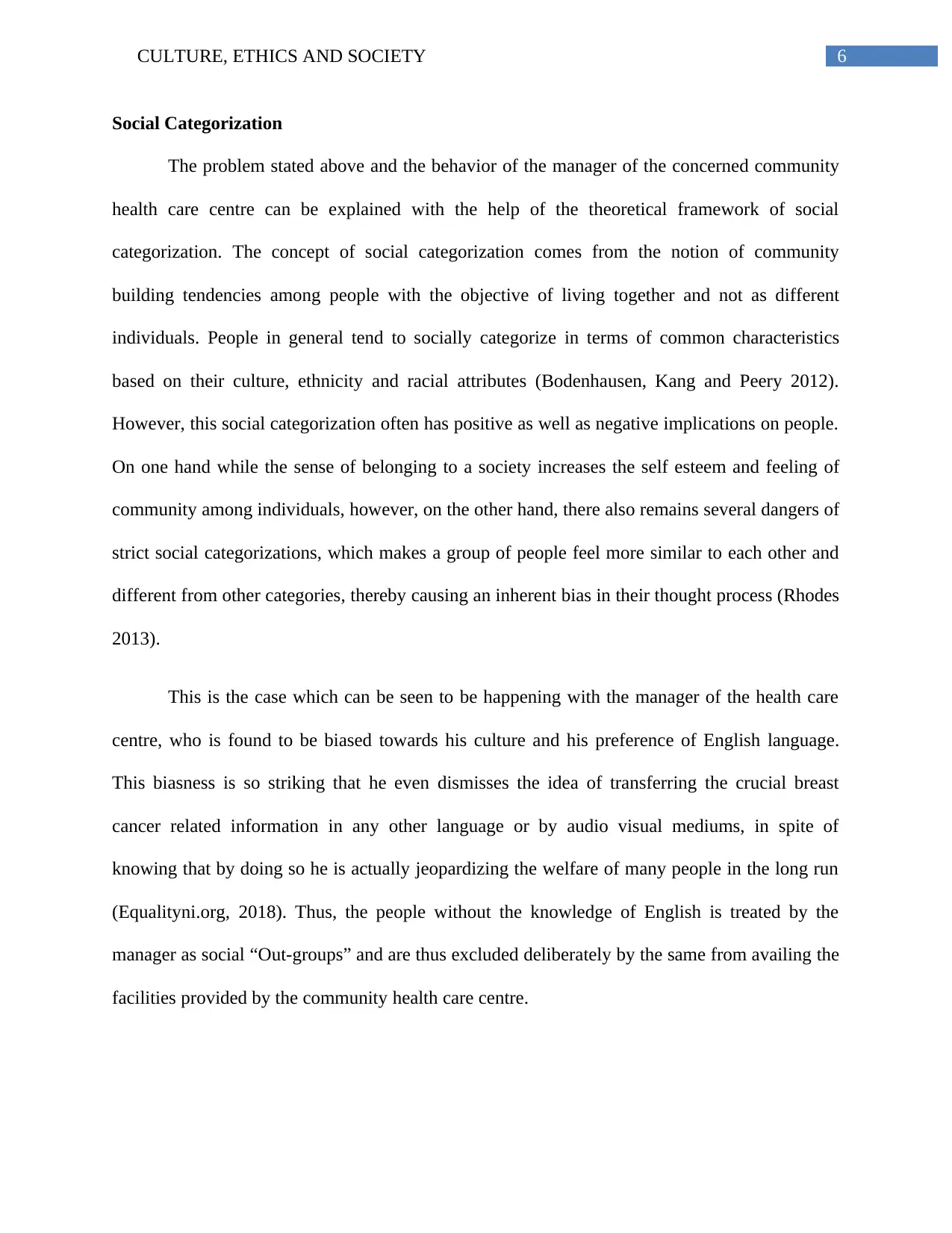
6CULTURE, ETHICS AND SOCIETY
Social Categorization
The problem stated above and the behavior of the manager of the concerned community
health care centre can be explained with the help of the theoretical framework of social
categorization. The concept of social categorization comes from the notion of community
building tendencies among people with the objective of living together and not as different
individuals. People in general tend to socially categorize in terms of common characteristics
based on their culture, ethnicity and racial attributes (Bodenhausen, Kang and Peery 2012).
However, this social categorization often has positive as well as negative implications on people.
On one hand while the sense of belonging to a society increases the self esteem and feeling of
community among individuals, however, on the other hand, there also remains several dangers of
strict social categorizations, which makes a group of people feel more similar to each other and
different from other categories, thereby causing an inherent bias in their thought process (Rhodes
2013).
This is the case which can be seen to be happening with the manager of the health care
centre, who is found to be biased towards his culture and his preference of English language.
This biasness is so striking that he even dismisses the idea of transferring the crucial breast
cancer related information in any other language or by audio visual mediums, in spite of
knowing that by doing so he is actually jeopardizing the welfare of many people in the long run
(Equalityni.org, 2018). Thus, the people without the knowledge of English is treated by the
manager as social “Out-groups” and are thus excluded deliberately by the same from availing the
facilities provided by the community health care centre.
Social Categorization
The problem stated above and the behavior of the manager of the concerned community
health care centre can be explained with the help of the theoretical framework of social
categorization. The concept of social categorization comes from the notion of community
building tendencies among people with the objective of living together and not as different
individuals. People in general tend to socially categorize in terms of common characteristics
based on their culture, ethnicity and racial attributes (Bodenhausen, Kang and Peery 2012).
However, this social categorization often has positive as well as negative implications on people.
On one hand while the sense of belonging to a society increases the self esteem and feeling of
community among individuals, however, on the other hand, there also remains several dangers of
strict social categorizations, which makes a group of people feel more similar to each other and
different from other categories, thereby causing an inherent bias in their thought process (Rhodes
2013).
This is the case which can be seen to be happening with the manager of the health care
centre, who is found to be biased towards his culture and his preference of English language.
This biasness is so striking that he even dismisses the idea of transferring the crucial breast
cancer related information in any other language or by audio visual mediums, in spite of
knowing that by doing so he is actually jeopardizing the welfare of many people in the long run
(Equalityni.org, 2018). Thus, the people without the knowledge of English is treated by the
manager as social “Out-groups” and are thus excluded deliberately by the same from availing the
facilities provided by the community health care centre.
Paraphrase This Document
Need a fresh take? Get an instant paraphrase of this document with our AI Paraphraser
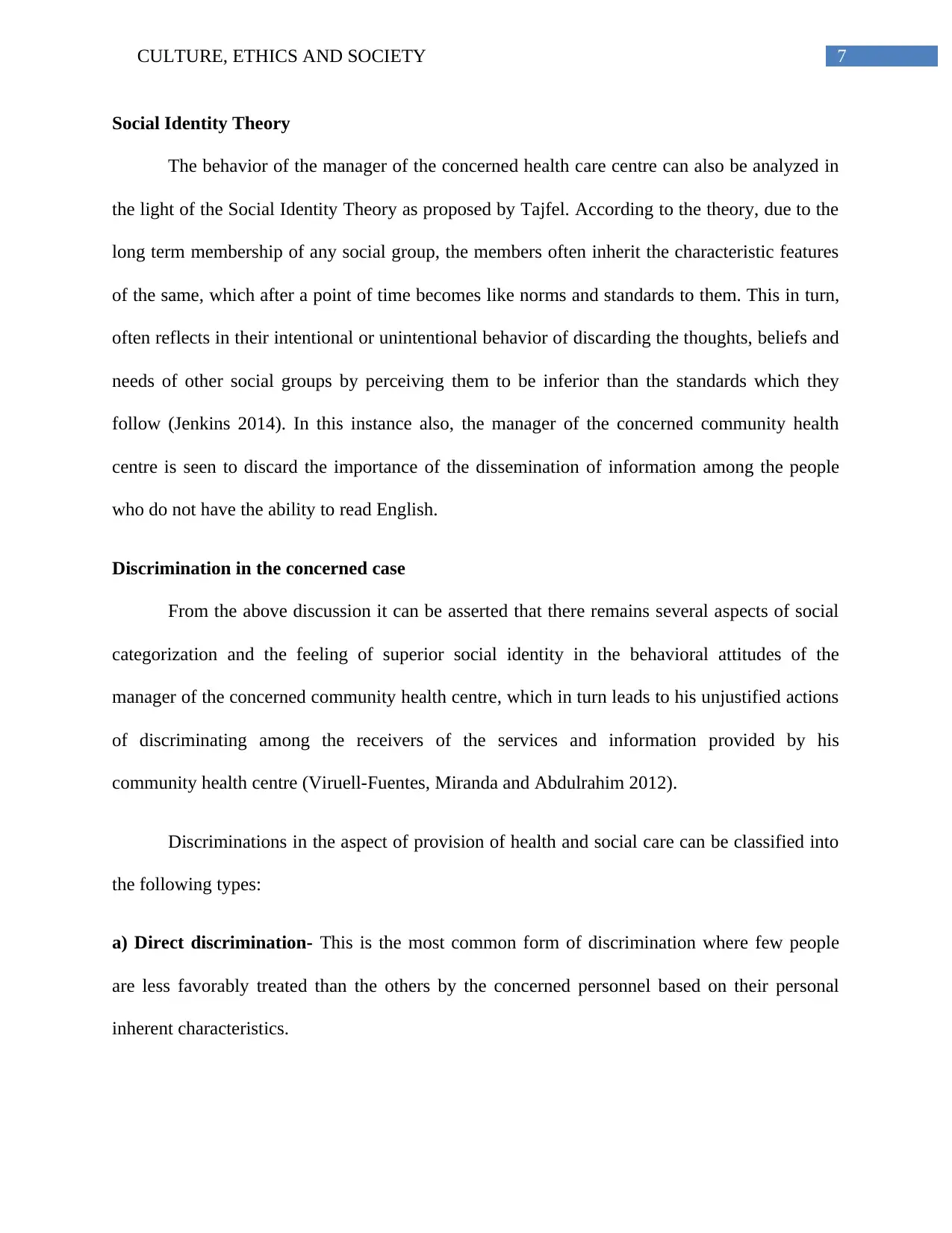
7CULTURE, ETHICS AND SOCIETY
Social Identity Theory
The behavior of the manager of the concerned health care centre can also be analyzed in
the light of the Social Identity Theory as proposed by Tajfel. According to the theory, due to the
long term membership of any social group, the members often inherit the characteristic features
of the same, which after a point of time becomes like norms and standards to them. This in turn,
often reflects in their intentional or unintentional behavior of discarding the thoughts, beliefs and
needs of other social groups by perceiving them to be inferior than the standards which they
follow (Jenkins 2014). In this instance also, the manager of the concerned community health
centre is seen to discard the importance of the dissemination of information among the people
who do not have the ability to read English.
Discrimination in the concerned case
From the above discussion it can be asserted that there remains several aspects of social
categorization and the feeling of superior social identity in the behavioral attitudes of the
manager of the concerned community health centre, which in turn leads to his unjustified actions
of discriminating among the receivers of the services and information provided by his
community health centre (Viruell-Fuentes, Miranda and Abdulrahim 2012).
Discriminations in the aspect of provision of health and social care can be classified into
the following types:
a) Direct discrimination- This is the most common form of discrimination where few people
are less favorably treated than the others by the concerned personnel based on their personal
inherent characteristics.
Social Identity Theory
The behavior of the manager of the concerned health care centre can also be analyzed in
the light of the Social Identity Theory as proposed by Tajfel. According to the theory, due to the
long term membership of any social group, the members often inherit the characteristic features
of the same, which after a point of time becomes like norms and standards to them. This in turn,
often reflects in their intentional or unintentional behavior of discarding the thoughts, beliefs and
needs of other social groups by perceiving them to be inferior than the standards which they
follow (Jenkins 2014). In this instance also, the manager of the concerned community health
centre is seen to discard the importance of the dissemination of information among the people
who do not have the ability to read English.
Discrimination in the concerned case
From the above discussion it can be asserted that there remains several aspects of social
categorization and the feeling of superior social identity in the behavioral attitudes of the
manager of the concerned community health centre, which in turn leads to his unjustified actions
of discriminating among the receivers of the services and information provided by his
community health centre (Viruell-Fuentes, Miranda and Abdulrahim 2012).
Discriminations in the aspect of provision of health and social care can be classified into
the following types:
a) Direct discrimination- This is the most common form of discrimination where few people
are less favorably treated than the others by the concerned personnel based on their personal
inherent characteristics.
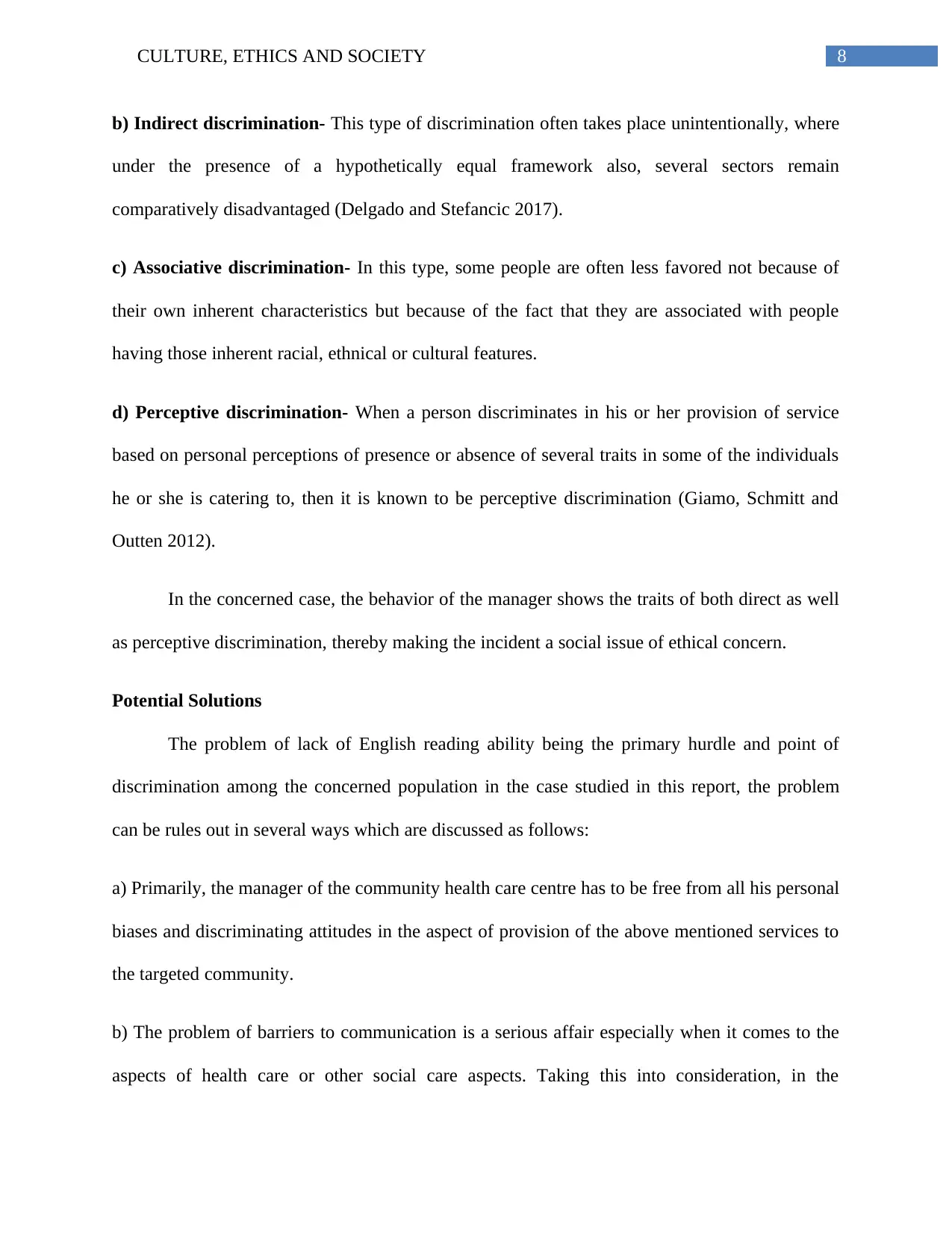
8CULTURE, ETHICS AND SOCIETY
b) Indirect discrimination- This type of discrimination often takes place unintentionally, where
under the presence of a hypothetically equal framework also, several sectors remain
comparatively disadvantaged (Delgado and Stefancic 2017).
c) Associative discrimination- In this type, some people are often less favored not because of
their own inherent characteristics but because of the fact that they are associated with people
having those inherent racial, ethnical or cultural features.
d) Perceptive discrimination- When a person discriminates in his or her provision of service
based on personal perceptions of presence or absence of several traits in some of the individuals
he or she is catering to, then it is known to be perceptive discrimination (Giamo, Schmitt and
Outten 2012).
In the concerned case, the behavior of the manager shows the traits of both direct as well
as perceptive discrimination, thereby making the incident a social issue of ethical concern.
Potential Solutions
The problem of lack of English reading ability being the primary hurdle and point of
discrimination among the concerned population in the case studied in this report, the problem
can be rules out in several ways which are discussed as follows:
a) Primarily, the manager of the community health care centre has to be free from all his personal
biases and discriminating attitudes in the aspect of provision of the above mentioned services to
the targeted community.
b) The problem of barriers to communication is a serious affair especially when it comes to the
aspects of health care or other social care aspects. Taking this into consideration, in the
b) Indirect discrimination- This type of discrimination often takes place unintentionally, where
under the presence of a hypothetically equal framework also, several sectors remain
comparatively disadvantaged (Delgado and Stefancic 2017).
c) Associative discrimination- In this type, some people are often less favored not because of
their own inherent characteristics but because of the fact that they are associated with people
having those inherent racial, ethnical or cultural features.
d) Perceptive discrimination- When a person discriminates in his or her provision of service
based on personal perceptions of presence or absence of several traits in some of the individuals
he or she is catering to, then it is known to be perceptive discrimination (Giamo, Schmitt and
Outten 2012).
In the concerned case, the behavior of the manager shows the traits of both direct as well
as perceptive discrimination, thereby making the incident a social issue of ethical concern.
Potential Solutions
The problem of lack of English reading ability being the primary hurdle and point of
discrimination among the concerned population in the case studied in this report, the problem
can be rules out in several ways which are discussed as follows:
a) Primarily, the manager of the community health care centre has to be free from all his personal
biases and discriminating attitudes in the aspect of provision of the above mentioned services to
the targeted community.
b) The problem of barriers to communication is a serious affair especially when it comes to the
aspects of health care or other social care aspects. Taking this into consideration, in the
⊘ This is a preview!⊘
Do you want full access?
Subscribe today to unlock all pages.

Trusted by 1+ million students worldwide
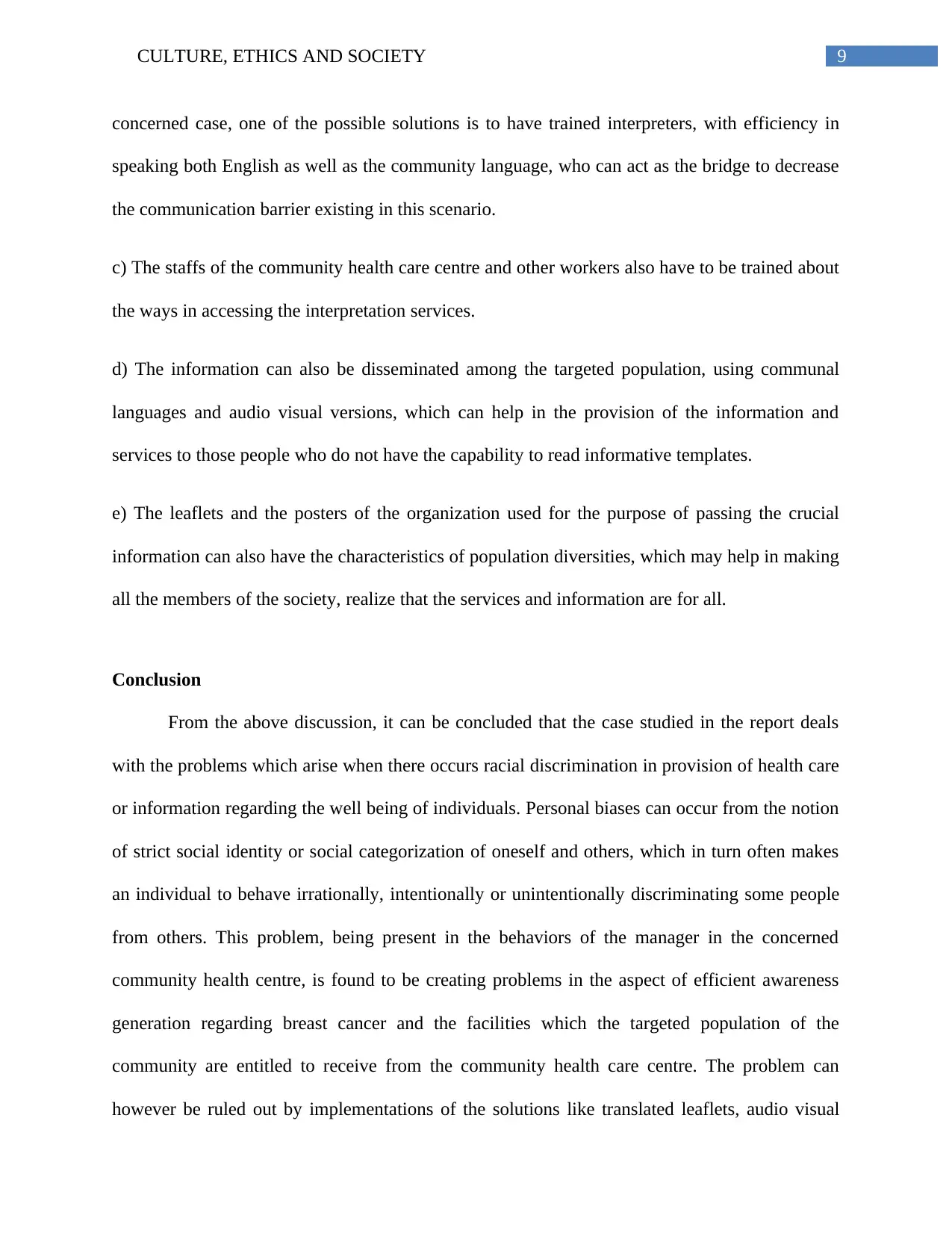
9CULTURE, ETHICS AND SOCIETY
concerned case, one of the possible solutions is to have trained interpreters, with efficiency in
speaking both English as well as the community language, who can act as the bridge to decrease
the communication barrier existing in this scenario.
c) The staffs of the community health care centre and other workers also have to be trained about
the ways in accessing the interpretation services.
d) The information can also be disseminated among the targeted population, using communal
languages and audio visual versions, which can help in the provision of the information and
services to those people who do not have the capability to read informative templates.
e) The leaflets and the posters of the organization used for the purpose of passing the crucial
information can also have the characteristics of population diversities, which may help in making
all the members of the society, realize that the services and information are for all.
Conclusion
From the above discussion, it can be concluded that the case studied in the report deals
with the problems which arise when there occurs racial discrimination in provision of health care
or information regarding the well being of individuals. Personal biases can occur from the notion
of strict social identity or social categorization of oneself and others, which in turn often makes
an individual to behave irrationally, intentionally or unintentionally discriminating some people
from others. This problem, being present in the behaviors of the manager in the concerned
community health centre, is found to be creating problems in the aspect of efficient awareness
generation regarding breast cancer and the facilities which the targeted population of the
community are entitled to receive from the community health care centre. The problem can
however be ruled out by implementations of the solutions like translated leaflets, audio visual
concerned case, one of the possible solutions is to have trained interpreters, with efficiency in
speaking both English as well as the community language, who can act as the bridge to decrease
the communication barrier existing in this scenario.
c) The staffs of the community health care centre and other workers also have to be trained about
the ways in accessing the interpretation services.
d) The information can also be disseminated among the targeted population, using communal
languages and audio visual versions, which can help in the provision of the information and
services to those people who do not have the capability to read informative templates.
e) The leaflets and the posters of the organization used for the purpose of passing the crucial
information can also have the characteristics of population diversities, which may help in making
all the members of the society, realize that the services and information are for all.
Conclusion
From the above discussion, it can be concluded that the case studied in the report deals
with the problems which arise when there occurs racial discrimination in provision of health care
or information regarding the well being of individuals. Personal biases can occur from the notion
of strict social identity or social categorization of oneself and others, which in turn often makes
an individual to behave irrationally, intentionally or unintentionally discriminating some people
from others. This problem, being present in the behaviors of the manager in the concerned
community health centre, is found to be creating problems in the aspect of efficient awareness
generation regarding breast cancer and the facilities which the targeted population of the
community are entitled to receive from the community health care centre. The problem can
however be ruled out by implementations of the solutions like translated leaflets, audio visual
Paraphrase This Document
Need a fresh take? Get an instant paraphrase of this document with our AI Paraphraser
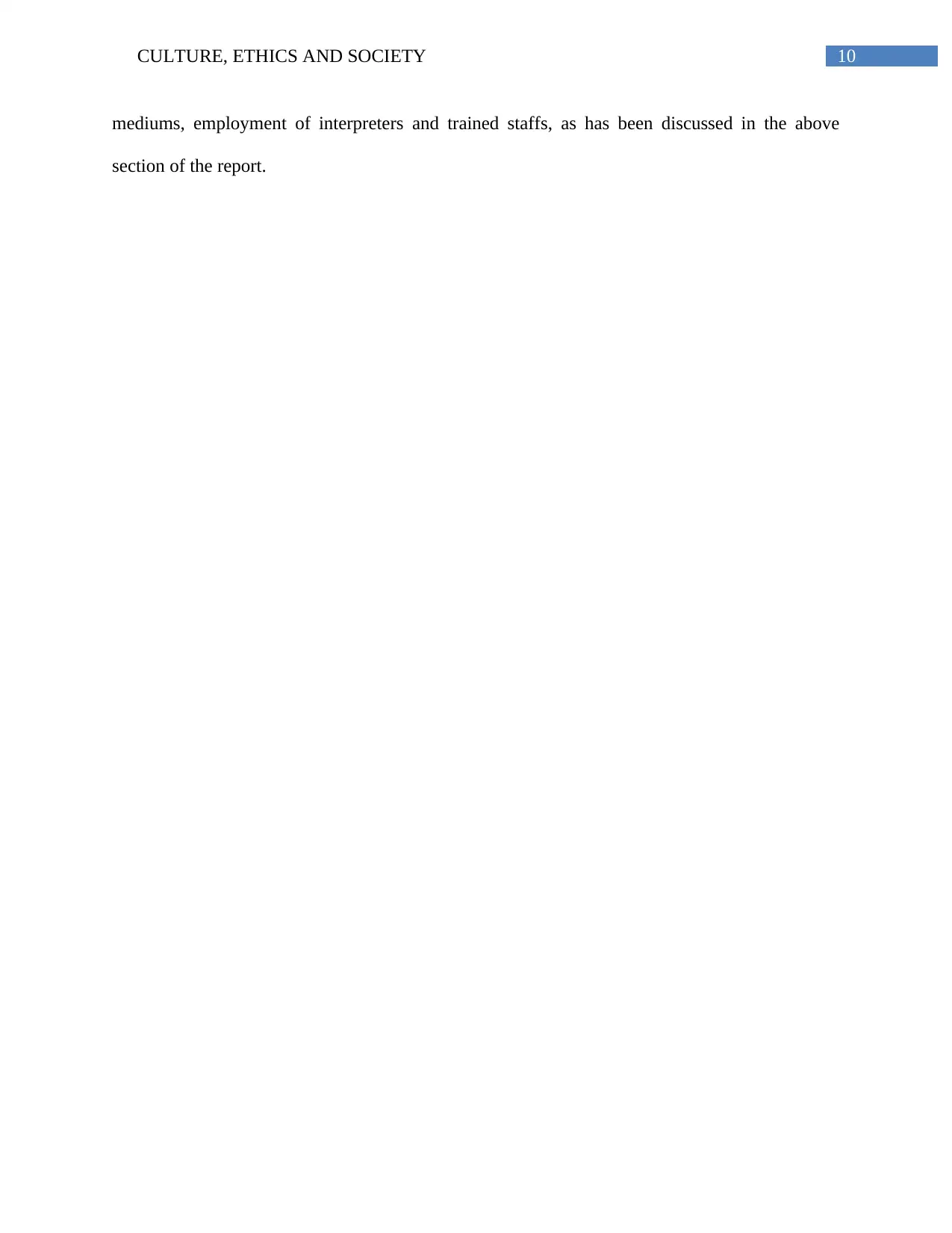
10CULTURE, ETHICS AND SOCIETY
mediums, employment of interpreters and trained staffs, as has been discussed in the above
section of the report.
mediums, employment of interpreters and trained staffs, as has been discussed in the above
section of the report.
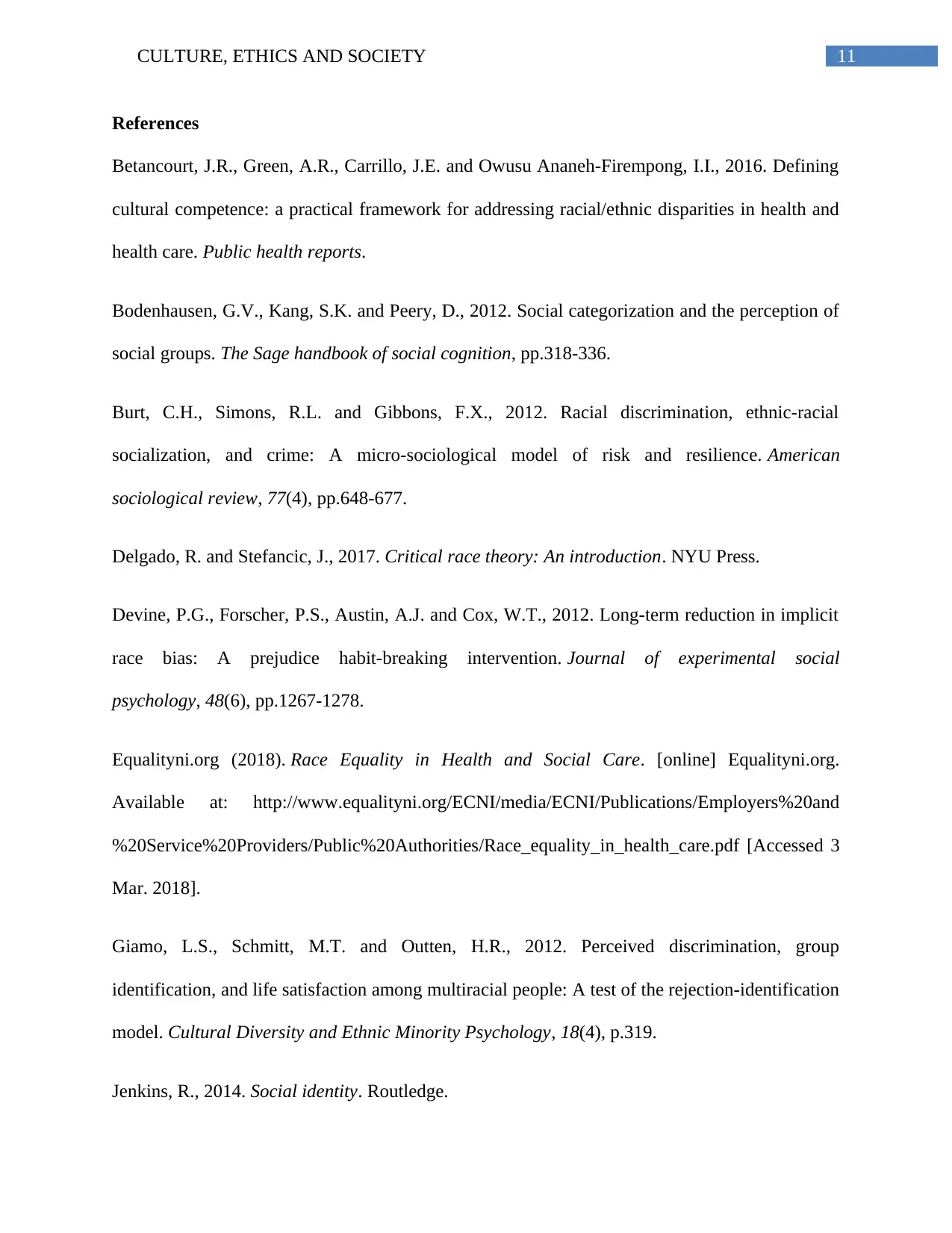
11CULTURE, ETHICS AND SOCIETY
References
Betancourt, J.R., Green, A.R., Carrillo, J.E. and Owusu Ananeh-Firempong, I.I., 2016. Defining
cultural competence: a practical framework for addressing racial/ethnic disparities in health and
health care. Public health reports.
Bodenhausen, G.V., Kang, S.K. and Peery, D., 2012. Social categorization and the perception of
social groups. The Sage handbook of social cognition, pp.318-336.
Burt, C.H., Simons, R.L. and Gibbons, F.X., 2012. Racial discrimination, ethnic-racial
socialization, and crime: A micro-sociological model of risk and resilience. American
sociological review, 77(4), pp.648-677.
Delgado, R. and Stefancic, J., 2017. Critical race theory: An introduction. NYU Press.
Devine, P.G., Forscher, P.S., Austin, A.J. and Cox, W.T., 2012. Long-term reduction in implicit
race bias: A prejudice habit-breaking intervention. Journal of experimental social
psychology, 48(6), pp.1267-1278.
Equalityni.org (2018). Race Equality in Health and Social Care. [online] Equalityni.org.
Available at: http://www.equalityni.org/ECNI/media/ECNI/Publications/Employers%20and
%20Service%20Providers/Public%20Authorities/Race_equality_in_health_care.pdf [Accessed 3
Mar. 2018].
Giamo, L.S., Schmitt, M.T. and Outten, H.R., 2012. Perceived discrimination, group
identification, and life satisfaction among multiracial people: A test of the rejection-identification
model. Cultural Diversity and Ethnic Minority Psychology, 18(4), p.319.
Jenkins, R., 2014. Social identity. Routledge.
References
Betancourt, J.R., Green, A.R., Carrillo, J.E. and Owusu Ananeh-Firempong, I.I., 2016. Defining
cultural competence: a practical framework for addressing racial/ethnic disparities in health and
health care. Public health reports.
Bodenhausen, G.V., Kang, S.K. and Peery, D., 2012. Social categorization and the perception of
social groups. The Sage handbook of social cognition, pp.318-336.
Burt, C.H., Simons, R.L. and Gibbons, F.X., 2012. Racial discrimination, ethnic-racial
socialization, and crime: A micro-sociological model of risk and resilience. American
sociological review, 77(4), pp.648-677.
Delgado, R. and Stefancic, J., 2017. Critical race theory: An introduction. NYU Press.
Devine, P.G., Forscher, P.S., Austin, A.J. and Cox, W.T., 2012. Long-term reduction in implicit
race bias: A prejudice habit-breaking intervention. Journal of experimental social
psychology, 48(6), pp.1267-1278.
Equalityni.org (2018). Race Equality in Health and Social Care. [online] Equalityni.org.
Available at: http://www.equalityni.org/ECNI/media/ECNI/Publications/Employers%20and
%20Service%20Providers/Public%20Authorities/Race_equality_in_health_care.pdf [Accessed 3
Mar. 2018].
Giamo, L.S., Schmitt, M.T. and Outten, H.R., 2012. Perceived discrimination, group
identification, and life satisfaction among multiracial people: A test of the rejection-identification
model. Cultural Diversity and Ethnic Minority Psychology, 18(4), p.319.
Jenkins, R., 2014. Social identity. Routledge.
⊘ This is a preview!⊘
Do you want full access?
Subscribe today to unlock all pages.

Trusted by 1+ million students worldwide
1 out of 13
Related Documents
Your All-in-One AI-Powered Toolkit for Academic Success.
+13062052269
info@desklib.com
Available 24*7 on WhatsApp / Email
![[object Object]](/_next/static/media/star-bottom.7253800d.svg)
Unlock your academic potential
Copyright © 2020–2025 A2Z Services. All Rights Reserved. Developed and managed by ZUCOL.





